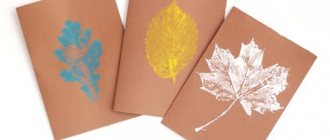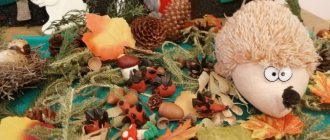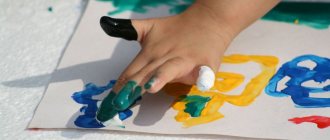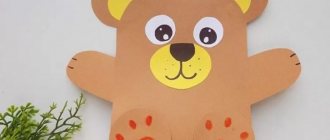Summary of a lesson on application in the first junior group of a preschool educational institution
Lesson summary for the first junior group “Decorating a hat for Mishka.”
Author : Zolotukhna Nadezhda Gennadievna MDOU No. 113 “Gulliver”, Volzhsky. Integration of educational areas : cognitive, artistic and aesthetic. Goal : to develop independent application, learn to put glue on a brush, spread ready-made shapes on oilcloth, use a napkin to remove excess glue. We fix the colors: yellow and red. Cultivate accuracy in work. Material. Hat templates according to the number of children, cut out of white cardboard, yellow circles, red circles, 2 tassels, PVA glue, oilcloth, napkins, Teddy Bear toy. Progress of the game-lesson. Prepare for class by laying out materials and tools on the table. Tell your child that Mishka (sit him on the table) really wants to have a beautiful hat, and invite the child to decorate the hat with red and yellow circles. Fizminutka Where is your hat? Well, look! Get dressed, honey, One, two, and three. Hat, hat It makes your ears warmer. Hat, hat, warm the baby. Where is your hat? It's time to go. Get ready, honey, the kids are waiting for us. Hat, hat It makes your ears warmer. Hat, hat, warm the baby. Glue the first element of the pattern onto your hat, apply glue to the second circle and, guiding the child’s hand, help him stick it on. Then stick a circle and help your baby do the same. Offer to glue the last circle in the pattern to the child yourself. After finishing work, enjoy the beautiful hat with Mishka. Play with her. Say again: “This is a red circle. This is a yellow circle." Even if the baby cannot repeat these words after you, he will definitely remember them. The duration of the lesson is no more than 10 minutes. Organize an exhibition and praise the children!
We recommend watching:
Summary of a game (integrated) lesson on environmental education for the 2nd junior group. A summary of the GCD in the junior group on traffic rules. A synopsis of the GCD on social and communicative development for the 2nd junior group. A synopsis of the GCD for physical education in the second junior group.
Similar articles:
Lesson summary for an early age group. Vegetables: turnips and carrots
Lesson summary for an early age group. Vegetables: beets and potatoes
Lesson summary for an early age group. Fruits: lemon and orange
Lesson summary for an early age group. Cat with kittens
Summary of a lesson in an early age group on a winter theme. Hare and fox
Notes on the topic “Elegant clothing” outline of a lesson on applique, modeling (junior group)
Synopsis “Elegant clothes”
Goal: To strengthen children's skills in using glue
Tasks:
- develop artistic taste during appliqué and evoke a desire to work
- strengthen children's skills in correctly positioning the pattern and using a napkin when making appliqué.
- create a desire to work.
Demonstration material: Dress, shirt, parcel, letter. Handouts: colored paper, glue, dress templates, colored paper sequins.
Progress of the game:
Surprise moment: Teacher: Guys, today we are with you... oh, do you hear someone knocking, so loudly! (The teacher opens the door to no one - there is a package lying there). Guys, we have received a package. Let's see what's there.
Children: Let's go. Educator: Oh, look, what is this? It seems to me that these are some kind of decorations, and there is also a letter here, let's read it.
The teacher reads the letter: “Guys, hello. I need your help. The sewing machines in our studio have broken down, and we can’t make dresses and shirts for our models. Help me please. I sent you jewelry for new clothes in a parcel.
Educator: Well, guys, can we help?
Children: Yes!
Educator: Then let's get to work, now I will distribute materials for making clothes to each of you.
The teacher distributes to the children the materials that were in the parcel (blank dresses, sequins made of colored paper)
Educator: Guys, we will now turn into tailors. We have a lot of work and our arms and legs can get tired. Let's strengthen them with exercises.
Children: Yes!
Phys. minute "Tailor"
Needle, Needle, sew faster - (Children imitate the movement of their hands with a needle when sewing).
We sew clothes for friends. (Clap their hands.)
Matryoshka, teddy bear, Lada doll (count fingers).
Let's dress in new outfits! (They show clothes).
Educator: Well done, you completed all the movements quickly and clearly, and now let’s get started with our dresses. Guys, look how many decorations we have, you can choose the ones you like, and I will show you how you can decorate the dresses. I will apply a drop of glue to my jewelry and apply it to the dress. It's working out great! Now decorate your dresses. (Individual assistance during the decoration of blanks, assistance in choosing colors for a harmonious combination.)
Educator: Guys, just look at what beautiful dresses we made! What is the name of the decoration we used to decorate it with? (Children answer.) Let's make our own clothing exhibition, your dresses and shirts are so beautiful! Let's admire it and then send it to the studio. Now we will place the outfits for the exhibition.
Reflection:
What did you guys like or dislike? What difficulties did you have? How did you figure this out?
Lesson summary on Appliqué for children of the 2nd junior group “Polka Dot Dress”.
"Polka-dot dress".
Educational area:
Artistic creativity.
Tasks:
Educational:
Arouse interest and desire to engage.
To cultivate artistic taste, patience, attention, observation. Cultivate the ability to empathize and provide help to those who need it. Educational:
Teach children to choose the right color to decorate the dress in accordance with the color of the bow on the dress.
Strengthen the ability to name the colors green, yellow, red and shape. Develop the ability to carefully use glue, spread it with a brush in a thin layer on the back side of the figure to be glued; apply the side coated with glue to a sheet of paper and press tightly with a napkin. Developmental:
Develop the ability to create applique on paper of various shapes.
Materials and equipment:
Flannelograph, doll, dress with a bow (sample), yellow, red and green mugs for decorating dresses.
Handouts:
dresses, yellow, red and green mugs, glue, brush, napkins.
Health-saving technologies:
Su-jok therapy, corrective health paths - for the prevention of flat feet.
Progress of the lesson.
Motivational – incentive stage.
Educator:
Guys, today we will have an unusual activity. Today we will go to a Fairy Tale. But to get there we need to follow a magical path. (Children, together with the teacher, walk along the corrective health path). Guys, do you hear crying? What is this? (In the middle of the hall, in a flower meadow, in a large flower) there is a doll sitting.
Organizational and search stage.
Let's start the lesson.
Guys, who is this? Children's answers. Children, let's ask her what her name is. Her name is Thumbelina. Look how beautiful and elegant she is. “To be polite, you must say hello!” Let's say hello to her (Children shake hands with the doll).
Guys, Thumbelina asks us to help her. Thumbelina was given a dress (shown on a flannelgraph). But there is no pattern on it at all. Thumbelina wants the children to decorate her dress. Shall we help Thumbelina? (Yes).
Look what dress they gave to Thumbelina. What color is it? (Red) Children's answers. And what's on the dress? (Bow). Tell me, what color is the bow on the dress? (Yellow).
Well done. And now Thumbelina invites us to a physical session.
Physical exercise: “Dance.”
Two roaring laughter (we turn our hands towards ourselves and away from ourselves),
They dance the “Taratushki” dance (we move our hands in the indicated direction),
They dance further, they dance closer (we move our hands in the indicated direction),
They dance higher, they dance lower (hands up and down).
Stomp with your foot, stomp again (stomp),
They dance dashingly, stamp and stamp (we stomp and clap).
Now let's decorate the dress for Thumbelina. Look, we will decorate with circles like these. What is this? Circles. What are they like? For polka dots. What color are they? Green, red, yellow. With green circles, which dress will we decorate? Dress with a green bow. Are the circles and bow the same color? (Yes). Which dress will we glue the yellow circles on? (On a dress with a yellow bow). Well done.
Let's remember how we glue: take a little glue, spread it on a circle, glue it, press it on top with a napkin. The children sit at the tables. But before you start, let's do some hand exercises. Exercise Su-Jock therapy.
I roll the ball around
I drive him back and forth,
I stroke their palm, as if I were sweeping away a crumb,
And I’ll squeeze it a little, like a cat squeezes its paw.
I'll press with each finger,
And I'll start with the other hand. (Children roll a ball between their palms).
Well done. Now look carefully at the dress that is on your tables and take the mugs of the same color as the bow.
Now let’s glue the circles and decorate the dress with them. (Children work with handouts independently).
Reflexive - corrective stage.
Well, all the dresses have been decorated. Very beautiful. Look, the bow and circles on the dresses are the same color? (Evaluation of children's work). Thumbelina really liked your dresses. And now it’s time for us to return to kindergarten. Let's say "Goodbye" to Thumbelina. Well done, guys, today you were able to not only help Thumbelina, but also taught her what you know. And the main thing is to be friends.
KGKP nursery – kindergarten “Bobek”
Lesson summary on Applications for children of the 2nd junior group.
Educator: Anosova E.V.
Application.
Notes on application in the 2nd junior group “Decoration - felt boots”
Notes on application in the 2nd junior group “Decoration - felt boots”
Program content:
“Artistic and aesthetic development”:
1. Strengthen in children the skill of spreading glue on an object and carefully gluing it. Use the acquired skill when creating a pattern to decorate a felt boot.
2. Continue to teach children how to position the pattern correctly and use a napkin when making appliqué.
"Social - communicative":
3. Activate the subject dictionary on the topic “Shoes”, naming geometric shapes. Form an explanatory speech.
"Cognitive development":
4. Develop visual perception, imagination, and the ability to establish cause-and-effect relationships.
"Physical development":
5. Develop fine motor skills of the fingers.
Methods and techniques.
Game situation: the arrival of the dog Sharik to the group, riddle, pictures, questions, explanation of the teacher, clarifications, additions, samples, practical activities, reminders, encouragement.
Health-saving technologies: changing static and dynamic poses, taking into account individual characteristics, finger gymnastics.
Progress of the lesson.
I. - Guys, Sharik came to visit us today and brought an interesting picture. Look at her.
-What do you see on it? (Fence, and legs under the fence).
-What are you wearing on your feet? (Felt boots).
- How many children do you think were hiding behind the fence? (2)
- How did you guess? (Close their eyes, open them - another picture).
-Did you guess correctly?
-Who do you see here?
Look at the bright colorful clothes the children have and the colorful hats they wear. What about felt boots? Are they patterned? (No) .
- Let's teach the kids how to decorate felt boots.
II. - Look how beautiful the pattern is (the teacher displays samples of the drawings).
-What does the pattern look like? (For the New Year tree).
— What geometric shapes is the pattern made of? (From triangles and circles).
— What color are the triangles? (green)
-What color are the circles (yellow, blue, red)
— A felt boot has a toe, a heel, and what part is the pattern on? (in the middle).
III. They sat down on the chairs.
— In front of you are felt boots and triangles.
- What should we do next? (spread with glue).
— How do we spread the glue? (Demonstration of sticking, explanation).
- Glue a large triangle at the bottom, a medium triangle at the top, and a small one at the very top. Glue from bottom to top..
Finger gymnastics “Herringbone”.
IV. Execution of work.
V. Summary of the lesson
- Let's make an exhibition of your works and look at them. Who got the most neat, bright, even pattern?
Author: Pryakhina Irina Olegovna
Unregulated activity “Man-made world: clothes and shoes”
Communication “Man-made world: clothes and shoes”
Monday
Reasoning “What are clothes made of”
Goal: developing ideas about the variety of clothing, the properties and qualities of objects.
Tuesday
Conversation “How girls and boys dress”
Goal: developing awareness of one’s gender identity.
Wednesday
Conversation about the work of a seamstress and shoemaker
Goal: developing ideas about the work of adults as a way of creating objects that people need.
Thursday
Conversation “How we notice disorder in clothes and correct it”
Goal: developing an idea of the need for self-service.
Friday
Sketch “Let's go through the mud” (depicting disgust)
Goal: to cultivate a caring attitude towards clothes and shoes.
Cognitive practical activity “Man-made world: clothes and shoes”
Monday
Examining the fabrics from which clothes are made
Goal: developing the ability to recognize the properties and qualities of objects.
Tuesday
Observing passersby (what they are wearing)
Goal: developing the ability to notice patterns and dependencies of objects and phenomena (if it’s cold, you need warm clothes).
Wednesday
Weather monitoring
Goal: developing the ability to determine the time of year based on characteristic features.
Thursday
Observation "Autumn Shoes"
Goal: developing the ability to notice the dependence of the choice of shoes on the weather (if it rains, you need to put on rubber boots).
Friday
Solving riddles about clothes and shoes
Goal: to consolidate ideas about the variety of clothes and shoes.
Game activity “Man-made world: clothes and shoes”
Monday
Didactic game “dress the doll for a walk”, “Undress the doll after the walk”
Goal: to reproduce in the game actions with toys related to everyday life.
Tuesday
Didactic game “Let’s show Mishka how to dress so as not to catch a cold”
Goal: formation of an algorithm for undressing and dressing.
Wednesday
Didactic game “Let’s iron the doll’s dress”
Goal: developing an understanding of clothing care
Thursday
Didactic game “When is this worn?”
Goal: strengthening the ability to establish a relationship between weather conditions and clothing.
Friday
Didactic game “What’s extra?”
Purpose: comparison of objects by function and purpose.
Artistic activity “Man-made world: clothes and shoes”
Monday
Looking at pictures of clothes and shoes
Goal: developing the ability to see a variety of items of clothing and footwear, to recognize their properties and qualities.
Tuesday
Reading works: “Our Little Masha”, “Shoes” by A. Barto, “My Teddy Bear” by Z. Alexandrova, “Whose Shoes?” N. Pavlova
Goal: introducing children to accessible literary works, developing the ability to answer adult questions.
Wednesday
Listening to the song “Mom Lesha bought excellent galoshes”
Goal: development of the ability to distinguish the nature of music.
Thursday
Listening to a fragment of P. Tchaikovsky’s work “The Seasons” (autumn) with free movements to the music
Goal: development of the ability to distinguish the nature of music.
Friday
Independent art activity with coloring books “Clothes”
Goal: development of the ability to hatch in different directions.




